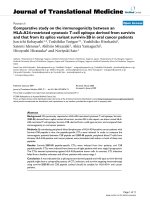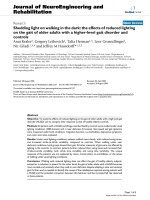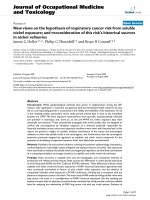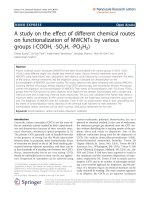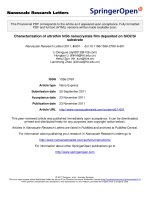Báo cáo hóa học: " Nano-embossing technology on ferroelectric thin film Pb(Zr0.3,Ti0.7)O3 for multi-bit storage application" potx
Bạn đang xem bản rút gọn của tài liệu. Xem và tải ngay bản đầy đủ của tài liệu tại đây (689.65 KB, 6 trang )
NANO EXPRESS Open Access
Nano-embossing technology on ferroelectric thin
film Pb(Zr
0.3
,Ti
0.7
)O
3
for multi-bit storage
application
Zhenkui Shen
1
, Zhihui Chen
1
, Qian Lu
2
, Zhijun Qiu
1
, Anquan Jiang
1
, Xinping Qu
1
, Yifang Chen
3*
and Ran Liu
1*
Abstract
In this work, we apply nano-embossing technique to form a stagger structure in ferroelectric lead zirconate titanate
[Pb(Zr
0.3
,Ti
0.7
)O
3
(PZT)] films and investigate the ferroelectric and electrical characterizations of the embossed and
un-embossed regions, respectively, of the same films by using piezoresponse force microscopy (PFM) and Radiant
Technologies Precision Material Analyzer. Attributed to the different layer thickness of the patterned ferroelectric
thin film, two distinctive coercive voltages have been obtained, thereby, allowing for a single ferroelectric memory
cell to contain more than one bit of data.
Introduction
The development of miniaturized ferroelectric field
effect transistors (FeFETs) and random access memo ries
(FeRAMs) [1,2] has called for fabrication of high-quality
ferroelectric nanostructures. How to retain excellent fer-
roelectricity in nanoscale patterned structures posts a
great challenge, as the small thickness of ultra thin films
as well as the damages and defects introduced by the
conventional photo lithography [3-6] could drastically
degrade the ferroelectric properties. Better controlling
the quality of the ultra-thin ferroelectric films and alter-
native patterning techniques are, therefore, highly
required.
It is widely understood that multi-bit operation could be
one of the most efficient approaches to increase storage
densities. In recent years, a great deal of efforts has been
made on realizing multi-v alue storage through circuit
design. One of the drawbacks is the additional budget of
densities in circuit integration. There have been rarely
reports on the research tackling the improvement of fabri-
cation processes and device structures. Nano-embossing
technology has emerged as a fast and cost effective techni-
que suitable for patterning structures with feature size
down to 20 nm, well below the li mit of other lithography
techniques used for mass production [7-11]. In this article,
we report our initial progress in developing a nano-
embossing technique to achieve large arrays of ferroelec-
tric PZT cells, which have potential application in mu lti-
bit storage based on ferroelectric nanostructures.
Since the principle of FeRAM is based on the polariza-
tion reversal by an externally applied electric field of
metal-ferroelectric-metal capacitors, the computational
‘0’and ‘1’ are represented by the nonvolatile storage of the
negative or positive remnant polarization state, respec-
tively [12]. The ferroelectric films with different thickness
need different c oercive voltages. A staggered structure
with two distinct thickness layers on a PZT thin film can
be readily created by a one-step embossing process. In
principle, the thinner layer should give rise to the lower
switch voltage and the thicker layer to the higher switch
voltage [13]. The voltage magnitude corresponds to one of
the two polarization charge levels stored in the ferroelec-
tric memory cell. In this way, multiple bits of data can be
obtained from a single ferroelectric memory cell by apply-
ing different voltages.
Scanning atomic force microscopy (AFM) was used to
study the morphology of the embossed arrays, whereas the
PFM, which is proved to be one of the most effective
method for t he nanoscale study and contro l of ferroelec-
tric domains in bulk crystals and thin films [14,15], was
applied for the study of polarization switching behavior of
patterned regions on a PZT film. A Radiant Technologies
Precision M aterial Analyzer was also used for electrical
* Correspondence: ;
1
ASIC & System State Key Laboratory, Department of Microelectronics, Fudan
University, Shanghai, 200433, China
3
Rutherford Appleton Laboratory, Chilton, Didcot, Oxfordshire, OX11 0QX, UK
Full list of author information is available at the end of the article
Shen et al. Nanoscale Research Letters 2011, 6:474
/>© 2011 Shen et al; licensee Springer. This is an Open Access article distributed under the terms of the Creative Commons Attributi on
License ( enses/by/2.0), which permits unrestrict ed use, distribution, and reproduction in any medium,
provided the original work is properly cited.
characterizations. The same measurements were also per-
formed on un-patterned regions for comparison.
Results and discussion
Figure 1a illustrates the nano-embossing process of fer-
roelectric PZT. Figure 1b displays the embossed PZT
film profiles measured by AFM; showing an embossed
depth of about 160 nm on a 450-nm thick PZT f ilm. It
could be seen that well quadrate patterned profiles of
the PZT film has been obtained by the nano-embossing
process. After crystallization, the morphology of the
embossed region remained stable and no collapse was
found even after several months. The embossed P ZT
films were found to be with [111] preferred orientation
and a tetragonal structure previously by X-ray diffrac-
tion and Raman spectroscopy (not presented here)
[13,16], respectively (Additional files 1 and 2). Figure 2
shows the hysteretic dependence of out-of-plane piezo-
response (OPP) phase under a bias from -10 to 10 V.
Theblueandredcurvesrepresentthehysteresisloops
of embossed top and bottom areas, respectively. The
polarization phase contrast is nearly 180° and the switch
voltage of embossed bottom area (thinner layer) is about
1.5 V, approximately 1.5 V smaller than the coercive
voltage of embossed top area (thicker layer). Rapid
saturationsarefoundataround3and4V,respectively.
This provides convincing evidence of excellent ferroelec-
tricity property of the embossed regions and demon-
strates that two distinct coercive voltages can be
generated by a one-step embossing process on ferroelec-
tric thin films.
We propose a method for operation of multi-bit storage
in embossed regions, which is schematically illustrated in
Figure 3a. For instance, after a minus bias -V2, which is
larger than the coercive voltage of the thicker film, is
added both o n the embossed and un-embossed regions,
the polarization of the ferroelectric film under electrode
pads could be wholly switched upward. Then with a plus
voltage V1 applied on, which is smaller than the coercive
voltage of the thicker film and larger than the coercive
voltage of the thinner film, the polarization of the
embossed bottom area can be switched downward. While
for the embossed top area and un-embossed region, the
polarization still keeps upward. In this way, an additional
Figure 1 PZT films nano-embossing proc ess and results of embossed profiles. (a) A schematic diagram illustrating a one-step embossing
process to form a stagger shape in a ferroelectric PZT film with two different thicknesses. (b) AFM images of embossed stagger like profiles of
ferroelectric PZT film.
Shen et al. Nanoscale Research Letters 2011, 6:474
/>Page 2 of 6
storage state for embossed region is apparently achieved.
Indeed, Figure 3b plots the ratio of the remnant polariza-
tion of the embossed region to that of the un-embossed
region on the same PZT film unde r voltages from 1 to 10
V. In the range of small voltages from 1 to 3 V, the polar-
ization of the embossed area is about four times as large
as that of the u n-embossed region, and, with the voltage
increasing to 5 V, the ratio d ecreases close to 1 . Thi s is
attributed to the fact that the thinner layer in the
embossed area could be more switched than the un-
embossed region (coercive voltage is approx. 3 V) under
low voltages such as 1 to 3 V. With the voltage rising to
Figure 2 Hysteretic dependence of OPP phase with applied voltage from -10 to 10 V for embossed top (blue) and b ottom regions
(red).
Figure 3 Sketch map of multi-bit storage operation and remnant polarization comparison between an embossed and an un-
embossed region. (a) Schematically illustration of multi-bit storage operation for embossed regions on a PZT film. (b) Remnant polarization
ratio of the embossed and the un-embossed regions in a PZT film in the voltage range from 1 to 10 V.
Shen et al. Nanoscale Research Letters 2011, 6:474
/>Page 3 of 6
5 V and above, both the embossed region and un-
embossed region could be almost swit che d, and thus the
remnant polarization for both regions with the same
electrode pad areas (100 × 100 μm square) approaches a
similar value.
Figure 4 shows the hysteresis loops of the embossed
region under external voltages of 5 and 3 V, respectively,
as well as that of the un-embossed region on the same
PZT thin film under 3 V for c omparison. All of the hys-
teresis loo ps under varies v oltages were measured from a
pre-polarized state. The remnant polarization under 3 V
for embossed region is 5.04 μc/cm
2
,whileforun-
embossed region is only 1.24 μc/cm
2
.Thissuggeststwo
remnant polarization states can be created for ‘ 10’ and
‘01’ states by switching the polarization of thinner layer
at a lower voltage. Correspo ndingly, when the polariza-
tion of whole lay er was switched at a higher v oltage,
another two stor age states ‘11’ and ‘ 00’ are obtained. As
illustrated schematically in Figure 4, four storage states
can be achieved in the embossed region.
Fatigue measurements were done at room temperature
using a Radiant Technologies Precision Tester. Both
embossed and un-embossed regions were subjected to
bipolar square wave voltage cycling with a width of 0.5
μs and period of 1 μs.Figure5displaysthechangein
switchable polarization as a function of the number of
switching cycles for both embossed and un-embossed
regionsonthesamePZTthinfilm.Itcanbeseenthat
un-embossed region is nearlyfatiguefreethrough10
7
cycles unde r a voltage of 5 V, while the switchable
polarization undergoes a slow decay starting at around
10
6
switching cycles for the embossed region under the
same voltage. This could be attributed to the fact that
the polarization of the thinner region in the embossed
area was much more switched than the un-embossed
region (coercive voltage is approx. 3 V) under the
applied voltage, and thus underwent an earlier decay.
Indeed, the switchable polarization of the embossed
region reached as many as 10
7
switching cycles with no
noticeable decay under a smaller voltage of 3 V. Further
studyonthefatigue[17-21]of the patterned ferroelec-
tric film capacitor structure is underway. The retention
characteristics of an embossed region have been
obtained by a PUND method with the pulse width and
amplitude of 1 ms and ± 8 V, respectively. Figure 6
shows the time dependence of the polarization, where
P
s
is the switched polarization between the two opposite
pulses and P
r
is the remnant polarization. As it can be
seen that ther e is no polarization de scending trend
observed even after retention time of 3200 s, clearly
confirming the excellent polarization phase maintained
after the removal of external fields for a long time.
Conclusions
In summary, we have successfully demonstrated a new
method to fabricate multi-bit memor y devices by
Figure 4 Hysteresis loops of the embossed region in the voltages of 3 and 5 V, respectively. The same loops obtained from the un-
embossed region of the same PZT thin film is obtained under 3 V for comparison.
Shen et al. Nanoscale Research Letters 2011, 6:474
/>Page 4 of 6
embossing on thin PZT films at room temperature to
form a stagger structure. More than one bit of data is
obtained from a single ferroelectric memory cell with
such a stagger configuration. Our process has the
advantages of high through put and low cost with a pro-
spect for fabricating m ulti-bit memory devices by the
developed embossing technique.
Experiment details
Ferroelectric PZT thin films were prepared on Pt/Ti/
SiO
2
/Si substrates by the sol-gel method. The raw mate-
rials were lead acetate trihydrate [Pb (OCOCH
3
)2.3H
2
O,
99.5%], zirconium tetra n-propoxide (Zr(OC
3
H
8
)
4
,70%),
titanium (IV) butoxide (Ti(OC
4
H
9
)
4
, 98%) as precursor
material and Methanol/Acetic acid mixed solvent as a
solvent. Figure 1a illustrates the embossing process of
the PZT film. After spin-on, the precursor film was first
baked on hotplate at 60°C in air for 5 min. Then, an
embossing process wa s carried out at room temperature
underapressureof9Mpafor15minusingasilicon
template, which has a grating 500 nm lines/spaces. The
template used was first coated with an anti-stick layer
on its surface in order to reduce its adhesion to the
embossed gels and make it easier in later de-mold pro-
cedure. Aft er embossing, the gel layers were first pyro-
lyzed in air on a hotplate at 350°C for 5 min and then
crystallized by conventional thermal annealing in air at
650°C for 15 min.
The PFM measurements of ferroelectric characteristics
of structured PZT films were carried out at room tem-
perature by a commercial multimode AFM with a Pt
coated cantilever (force constant 0.03 to 0.2 N/m, and
resonan t frequency 14 to 28 kHz). An ac voltage of 1 V
and frequency about 200 kHz was applied to measure
the in-field nanoscale hysteresis loops.
Further electrical characterization of the embossed
and un-embossed PZT ferroelectric films were per-
formed using a Radiant Technologies Precision Material
Analyzer with a triangular wave form at 1 kHz after
forming Au/Cr electrode pads (100 × 100 μmsquare)
on the films (Figure 3a).
Additional material
Additional file 1: XRD spectrum from an embossed region. XRD
spectrum from an embossed region suggests the embossed PZT film
grown with the preferable [111] orientation ([100], [110] [200] and [211]
peaks are much weaker).
Additional file 2: Raman spectrum taken from an embossed region.
The prominently intense, low-frequency modes at 141 and 199 cm
-1
relate to A
1
(1TO) and E(2TO)
T
mode, respectively. The peak at 504 and
602 cm
-1
correspond to E(3TO)
T
and A
1
(3TO) mode. These four modes
are relating to the tetragonal structure of the embossed PZT film rather
than the trigonal structure.
Abbreviations
AFM: atomic force microscopy; FeFETs: ferroelectric field effect transistors;
FeRAMs: ferroelectric random access memories; OPP: out-of-plane
piezoresponse; PFM: piezoresponse force microscopy.
Acknowledgements
This work was financially supported by National Basic Research Program of
China (2011CBA00603) and the 985” Micro/nanoelectronics Science and
Technology Innovation Platform at Fudan University.
Author details
1
ASIC & System State Key Laboratory, Department of Microelectronics, Fudan
University, Shanghai, 200433, China
2
Department of Material Science, Fudan
University, Shanghai, 200433, China
3
Rutherford Appleton Laboratory,
Chilton, Didcot, Oxfordshire, OX11 0QX, UK
Figure 5 Fatigue measurements from both embossed and un-
embossed areas. Change in switchable polarization as a function
of the number of switching cycles for both embossed region with
the biases of 5 and 3 V, respectively. Also shown in the figure is the
switching behavior from the un-embossed region on the same PZT
thin film under 5 V.
Figure 6 Time dependence of the polarization on an embossed
region from PUND measurements at room temperature.
Shen et al. Nanoscale Research Letters 2011, 6:474
/>Page 5 of 6
Authors’ contributions
ZKS, ZHC, and QL designed and carried out the experiments. YFC and RL
supervised the work. ZJQ, AQJ, and XPQ participated in the discussion. ZKS,
YFC, and RL wrote the manuscript. All authors read and approved the final
manuscript.
Competing interests
The authors declare that they have no competing interests.
Received: 24 December 2010 Accepted: 27 July 2011
Published: 27 July 2011
References
1. Scott JF: Application of modern ferroelectrics. Science 2007, 315:954-959.
2. Waser R, Rüdiger A: Ferroelectrics: pushing towards the digital storage
limit. Nat Mater 2004, 3:81-82.
3. Lee W, Han H, Lotnyk A, Schubert MA, Senz S, Alexe M, Hesse D, Baik S,
Gösele U: Indiviually addressable epitaxial ferroelectric nanocapacitor
with near tb inch
-2
density. Nat Nanotechnol 2008, 3:402-407.
4. Cofer A, Rajora P, Deornellas S, Keil D: Plasma etch processing of
advanced ferroelectric devices. Integr Ferroelectr 1997, 16:53-61.
5. Deornellas S, Rajora P, Cofer A: Challenges for plasma etch integration of
ferroelectric capacitors in FeRAM’s and DRAM’s. Integr Ferroelectr 1997,
17:395-402.
6. Ishihara K, Ishikawa T, Hamada K, Onishi S, Kudo J, Sakiyama K: The
degradation of ferroelectric properties of pzt thin films due to plasma
damage. Integr Ferroelectr 1995, 6:301-307.
7. Schift H: Nanoimprint lithography: an old story in modern times? A
review. J Vac Sci Technol B 2008, 26:458-480.
8. Guo LJ: Nanoimprint lithography: methods and material requirements.
Adv Mater 2007, 19:495.
9. Hu ZJ, Tian M, Nysten B, Jonas AM: Regular arrays of highly ordered
ferroelectric polymer nanostructrues for non-volatile low-voltage
memories. Nat Mater 2009, 8:62-67.
10. Zhang L, Ducharme S, Li JY: Microimprinting and ferroelectric properties
of poly(vinylidene fluoride-trifluoroethylene) copolymer films. Appl Phys
Lett 2007, 91:172906-172908.
11. Liu Y, Weiss DN, Li J: Rapid nanoimprinting and excellent piezorepsonse
of polymeric ferroelectric nanostructures. ACS Nano 2010, 4:83-90.
12. Setter N, Damjanovic D, Eng L, Fox G, Gevorgian S, Hong S, Kingon A,
Kohlstedt H, Park NY, Stephenson GB, Stolitchnov I, Taganstev AK,
Taylor DV, Yamada T, Streiffer S: Ferroelectric thin films: review of
materials, properties, and applications. J Appl Phys 2006,
100:051606-051651.
13. Shen ZK, Chen ZH, Qiu ZJ, Lu BR, Wang J, Deng SR, Jiang AQ, Qu XP, Liu R,
Chen YF: Influences of embossing technology on Pb(Zr
0.3
,Ti
0.7
)O
3
ferroelectric thin film. Micorelectron Eng 2010, 87:869-871.
14. Gruverman A, Kalinin SV: Piezoresponse force microscopy and recent
advances in nanoscale studies of ferroelectrics. J Mater Sci 2006,
41:107-116.
15. Ivry Y, Chu DP, Durkan C: Nanometer resolution piezorepsonse force
microscopy to study deep submicron ferroelectric and ferroelastic
domains. Appl Phys Lett 2009, 94:162903-162905.
16. Shen Z, Chen Z, Lu Q, Jiang A, Qiu Z, Qu X, Chen Y, Liu R:
Characterizations of nanoembossed Pb(Zr
0.3
,Ti
0.7
)O
3
ferroelectric films.
J Vac Sci Technol B 2010, 28:C6M28-C6M31.
17. Brazier M, McElfresh M, Mansour S: Origin of anomalous polarization
offsets in compositonally graded Pb(Zr, Ti)O
3
thin films. Appl Phys Lett
1999, 74:299-301.
18. Scott JF, Dawber M: Oxygen-vacancy ordering as a fatigue mechanism in
perovskite ferroelectrics. Appl Phys Lett 2000, 76:3801-3803.
19. Warren WL, Tuttle BA, Dimos DB: Ferroelectric fatigue in perovskite
oxides. Appl Phys Lett 1995, 67:1426-1428.
20. Jiang AQ, Lin YY, Tang TA: Coexisting depinning effect of domain walls
during the fatigue in ferroelectric thin films. Appl Phys Lett 2006,
89:032906-032906.
21. Jiang AQ, Lin YY, Tang TA: Charge injection and polarization fatigue in
ferroelectric thin films. J Appl Phys 2007, 102:074109-074117.
doi:10.1186/1556-276X-6-474
Cite this article as: Shen et al.: Nano-embossing technology on
ferroelectric thin film Pb(Zr
0.3
,Ti
0.7
)O
3
for multi-bit storage application.
Nanoscale Research Letters 2011 6:474.
Submit your manuscript to a
journal and benefi t from:
7 Convenient online submission
7 Rigorous peer review
7 Immediate publication on acceptance
7 Open access: articles freely available online
7 High visibility within the fi eld
7 Retaining the copyright to your article
Submit your next manuscript at 7 springeropen.com
Shen et al. Nanoscale Research Letters 2011, 6:474
/>Page 6 of 6
